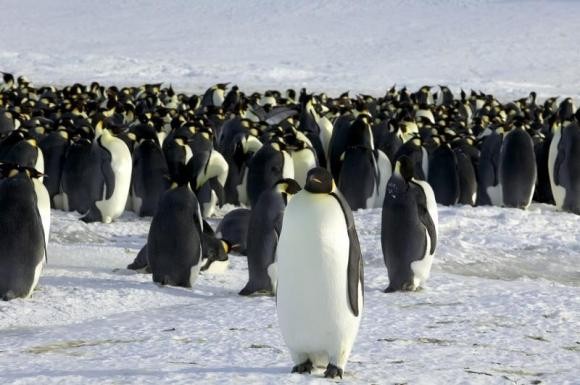Study Finds Only Three Groups of Emperor Penguins Survived the Last Ice Age
| Marco Foronda | | Mar 03, 2015 10:46 AM EST |
(Photo : REUTERS/MARTIN PASSINGHAM) Emperor penguins are seen in Dumont d'Urville, Antarctica.
A study argues that a change in breeding habits and distinct genetic make-up may have helped certain populations of the iconic Emperor Penguins survive the harsh climate during the last Ice Age.
Emperor Penguins can thrive at temperatures of -22 degrees Fahrenheit. But from around 26,500 to 19,000 years ago (during the time when Earth's glacial sheets where at the most widespread they've been since), populations were as much as seven times smaller than today.
Like Us on Facebook
Researchers from the universities of Southampton, Oxford, Tasmania and the Australian Antarctic Division traced modern Emperor Penguins back to three distinct genetic groups that survived the colder period.
They believe the three groups broke into small populations of refugees. These populations then became more prominent again once the world warmed-up. The Ross Sea in Antarctica was likely the refuge for one of the only three populations that survived,
One of the lead authors Gemma Clucas from University of Southampton explained the penguins were unable to breed in more than a few locations around Antarctica because there was twice as much sea ice during the last Ice Age.
"The distances from the open ocean, where the penguins feed, to the stable sea ice, where they breed, was probably too far. The three populations that did manage to survive may have done so by breeding near to polynyas -- areas of ocean that are kept free of sea ice by wind and currents," said Clucas.
Even though Emperor Penguins need glacial sheets, they also need access to the open ocean for feeding. In most parts of Antarctica, it appears the ice coverage proved too widespread for sufficient access to food.
The study was published in the journal Global Change Biology.
TagsEmperor Penguins, penguins, Ice age, glacial sheets, Antarctica, open ocean, animal survival
©2015 Chinatopix All rights reserved. Do not reproduce without permission
EDITOR'S PICKS
-

Did the Trump administration just announce plans for a trade war with ‘hostile’ China and Russia?
-

US Senate passes Taiwan travel bill slammed by China
-

As Yan Sihong’s family grieves, here are other Chinese students who went missing abroad. Some have never been found
-

Beijing blasts Western critics who ‘smear China’ with the term sharp power
-

China Envoy Seeks to Defuse Tensions With U.S. as a Trade War Brews
-

Singapore's Deputy PM Provides Bitcoin Vote of Confidence Amid China's Blanket Bans
-

China warns investors over risks in overseas virtual currency trading
-

Chinese government most trustworthy: survey
-

Kashima Antlers On Course For Back-To-Back Titles
MOST POPULAR
LATEST NEWS
Zhou Yongkang: China's Former Security Chief Sentenced to Life in Prison

China's former Chief of the Ministry of Public Security, Zhou Yongkang, has been given a life sentence after he was found guilty of abusing his office, bribery and deliberately ... Full Article
TRENDING STORY

China Pork Prices Expected to Stabilize As The Supplies Recover

Elephone P9000 Smartphone is now on Sale on Amazon India

There's a Big Chance Cliffhangers Won't Still Be Resolved When Grey's Anatomy Season 13 Returns

Supreme Court Ruled on Samsung vs Apple Dispute for Patent Infringement

Microsoft Surface Pro 5 Rumors and Release Date: What is the Latest?










